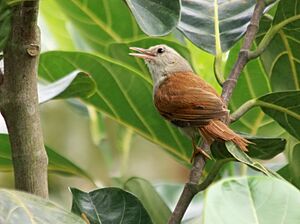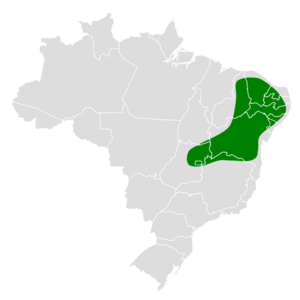Grey-headed spinetail facts for kids
Quick facts for kids Grey-headed spinetail |
|
|---|---|
 |
|
| Conservation status | |
| Scientific classification | |
| Genus: |
Cranioleuca
|
| Species: |
semicinerea
|
 |
|
The grey-headed spinetail (Cranioleuca semicinerea) is a cool bird that lives only in Brazil. It belongs to the ovenbird family called Furnariidae. These birds are known for building unique nests!
Contents
About the Grey-headed Spinetail
What Does it Look Like?
The grey-headed spinetail is about 14 to 16 centimeters (5.5 to 6.3 inches) long. That's about the length of a pen! It weighs around 14 to 16 grams (0.5 to 0.6 ounces), which is super light. Both male and female birds look the same.
They have a light gray face with a faint whitish stripe above their eye. A gray-brown line goes right through their eye. Their forehead is light buffy gray, and the top of their head and neck are a bit darker gray. They even have a short crest on their head!
Their back, tail, and wings are a reddish-brown color. Their tail feathers are special because they look spiny at the ends. Their throat and belly are light gray, while their chest and sides are a darker gray. Their eyes can be amber or dark brown. Their beak is dusky pink with a dark tip, and their legs and feet are olive to yellowish-green.
Where Does it Live?
This bird lives in eastern Brazil. You can find it from the state of Ceará down to Goiás and a little bit into Minas Gerais.
It likes to live in drier forests where trees lose their leaves, and also at the edges of forests where trees stay green all year. It usually lives in places that are between 500 and 850 meters (1,640 to 2,790 feet) high.
How Does it Behave?
Movement
The grey-headed spinetail stays in the same area all year round. It does not migrate to other places.
What Does it Eat?
This bird loves to eat arthropods, which are creatures like insects and spiders. It usually hunts for food in pairs. Often, you'll see them joining a group of different bird species all looking for food together. They are very acrobatic! They climb along small branches high up in the trees, picking off prey from the bark and other bits of nature.
Life Cycle and Reproduction
The grey-headed spinetail builds a cool nest! It's shaped like an oval ball and is made of moss and small roots. It has an entrance on the side. They usually build their nests wrapped around a horizontal branch, about 5 to 12 meters (16 to 39 feet) above the ground. Both parent birds help feed their babies. We don't know much more about their breeding habits right now!
What Sounds Does it Make?
The grey-headed spinetail has a very high-pitched song. It sounds like "tsit-tsit-tsit-" and then bounces down into a rattling sound. Its call is a high "trwit".
Status of the Grey-headed Spinetail
The IUCN (International Union for Conservation of Nature) says the grey-headed spinetail is a species of "Least Concern." This means it's not in immediate danger of disappearing.
However, even though it has a fairly large area where it lives, its population size is not known and is thought to be getting smaller. There are no big, immediate threats identified for this bird. It's considered rare to uncommon in many places.
This bird lives in a special band of forest that is between the wet evergreen forests near the coast and the drier woodlands inland. This area is heavily used by people for growing coffee, cutting timber, and farming. Because of this, only a small part of its original home is left.


